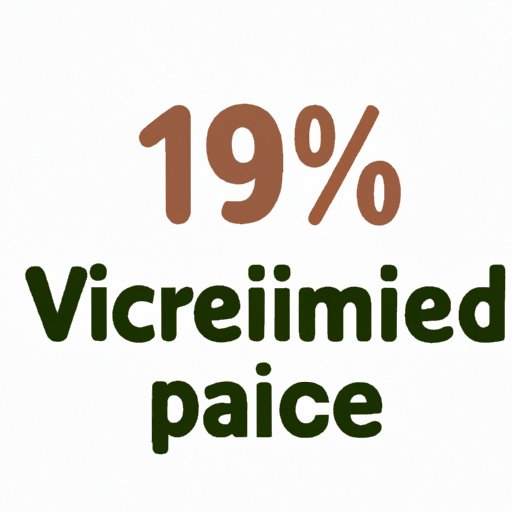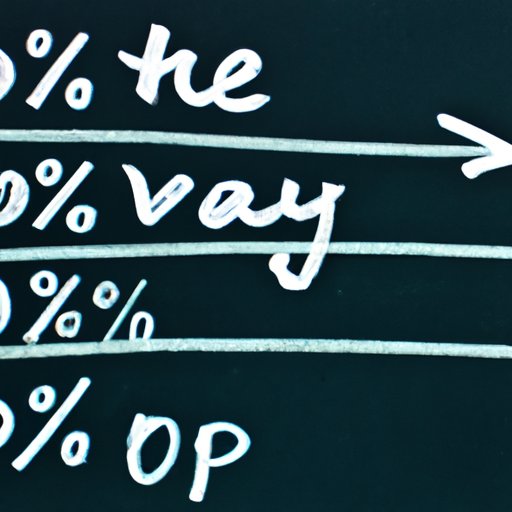I. Introduction
Percentages are an essential part of our everyday life, and knowing how to calculate them is vital in various fields like finance, mathematics, and science. Understanding percentages and how to calculate them can help you make informed decisions, estimate quantities, and interpret data, among many other things. This article aims to provide a comprehensive guide on how to find a percentage of a number, regardless of your skill level.
II. Simple Steps to Finding a Percentage of a Number for Beginners
If you’re new to percentages, don’t worry! It’s effortless to learn how to calculate a percentage of a number. A percentage is a way of expressing a portion or part of a whole as parts per one hundred. For example, 50% means 50 parts per hundred.
To calculate a percentage of a number, follow these simple steps:
- Convert the percentage to a decimal. To do this, divide the percentage by 100.
- Multiply the decimal by the number you want to find the percentage of.
- The result is your answer.
For example, to find 30% of 100:
- 30% = 0.30 (divide 30 by 100).
- 0.30 x 100 = 30.
- 30 is 30% of 100.
It’s that simple! Let’s look at a few more examples:
- To find 25% of 80:
- 25% = 0.25 (divide 25 by 100).
- 0.25 x 80 = 20.
- 20 is 25% of 80.
- To find 75% of 48:
- 75% = 0.75 (divide 75 by 100).
- 0.75 x 48 = 36.
- 36 is 75% of 48.
With a few practice problems, you can easily master the skill of finding percentages of numbers.
III. The Importance of Knowing How to Calculate Percentages and How to Do It Easily
Knowing how to calculate percentages is crucial because it helps you make smart decisions. For example, understanding percentage discounts allows you to buy items for less money, and working with percentages allows you to compare different data sets and make informed conclusions.
There are various methods to make percentage calculations fast and easy. For instance, breaking down percentages to pairs of 25s, 50s, and 10s can make calculations more manageable and quicker. Multiplying by 25 is equivalent to dividing by 4, while multiplying by 50 is the same as dividing by 2, which can be convenient. For example, to find 27.5% of 400:
- 25% of 400 = 100 (since dividing by 4 is the same as multiplying by 0.25).
- 2.5% of 400 = 10 (divide 25 by 10).
- 27.5% of 400 = 100 + 10 = 110.
Breaking down percentages into smaller, easier-to-calculate percentages can make calculations more manageable and increase your overall accuracy.
IV. Mastering the Art of Finding Percentages: Tricks That Will Save You Time and Trouble
Once you understand the basics of how to find a percentage of a number, you can advance to more challenging problems. There are several mental math techniques that can help you perform calculations without using a calculator and make the process more maintainable.
For example, to find percentages ending in 5, you can multiply the number by 10 and divide the result by 2. Let’s say we want to find 35% of 200:
- Multiply 200 by 10 = 2000.
- Divide 2000 by 2 = 1000.
- Drop the last digit, and the result is 700. 35% of 200 is 70.
Another useful technique is to use the rule of 72, which tells you how long it takes to double your money at a given interest rate. To use this rule, divide 72 by the interest rate, and the result is the number of years it takes to double your money. For example, if the interest rate is 8%, it will take approximately nine years to double your money (72 / 8 = 9).
V. Visualizing the Process: A Comprehensive Guide on How to Find Percentages Using Diagrams
Using visual aids and diagrams can help you understand how to calculate percentages better. One useful representation is the ‘percent triangle.’ This triangle displays the three steps to finding a percentage of a number. The base of the triangle represents 100%, while the other two corners represent the percentage you’re looking for and the number you want a percentage of, respectively. To find the percentage, cover the corner representing the percentage you’re looking for and perform the calculation using the remaining two corners.
Another useful diagram is the pie chart. Pie charts represent data as percentages of a whole, and they are an excellent tool to help you visualize percentage data. To find a percentage of a pie chart, determine the total number of sections and the number of sections representing your desired percentage. Then, divide the sections representing your percentage by the total number of sections and multiply the result by 100.

VI. Using Practical Examples to Teach You How to Find Percentages Accurately and Effectively
Real-life examples help contextualize percentage calculations and demonstrate their real-world implications. Let’s consider a few examples:
- Calculating tax percentages: Suppose you want to buy a $200 item that has a 10% sales tax. To find the total price, you need to calculate the tax amount first.
- 10% of 200 = 20.
- Add the tax and the original amount: $200 + $20 = $220.
- The item’s total price with tax is $220.
- Calculating discount percentages: Imagine you’re shopping during a sale, and a $100 sweater is discounted by 20%. How much do you save?
- 20% of 100 = 20.
- The item’s sale price is $100 – $20 = $80.
- You save $20, or 20%, off the original price.
- Analyze survey data: Suppose 60 out of 1000 people surveyed prefer brand A. What percentage of people surveyed prefer brand A?
- 60 / 1000 = 0.06
- 0.06 x 100 = 6%
- 6% of the people surveyed prefer brand A.
Try some practice problems to test your understanding.
VII. The Role of Percentages in Daily Life and How to Quickly Calculate Them Without a Calculator
Percentages are a crucial part of many aspects of daily life, from calculating weight loss progress to comparing cellphone plans. Understanding percentages can help you make informed decisions and simplify calculations. There are several mental math techniques that can help you calculate percentages without a calculator quickly.
For example, suppose you want to find 15% of 200. You can quickly do this calculation without a calculator by mentally taking 10% of 200 (which is 20), halving it to get 5, and then adding them together to get 25.
Another useful technique for mental percentage calculations is to use fractions. To find 30% of 80, you can convert 30% to a fraction (3/10) and then multiply that fraction by 80:
- 30% = 3/10
- 3/10 x 80 = 24
- 30% of 80 is 24.
Using fractions can make it easier to perform mental percentage calculations and avoid common mistakes.
VIII. Conclusion
A basic understanding of percentages is essential for everyday life and various fields, including mathematics, finance, and science. With this comprehensive guide, you should feel confident in knowing how to calculate percentages accurately and effectively. Whether you’re a beginner or an advanced learner, there’s always more to learn and ways to improve your percentage calculation skills. Practice makes perfect, so keep working to master this essential skill.
